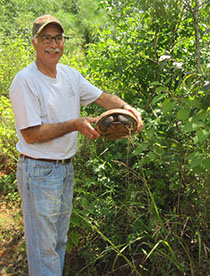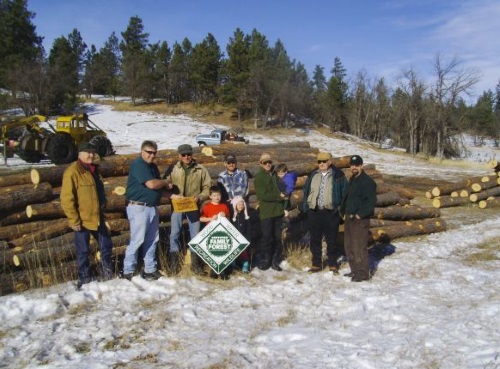Storytelling Resources for our Tree Farm Leaders
Storytelling has been around for ages. But for you, our Tree
Farm committee leaders and volunteers, sharing stories can be a compelling communications
tool to help you accomplish your goals as a committee.
goals as a committee.
Consider what storytelling can do for you:
- Help potential Tree Farmers see the value in the American Tree Farm System and want to join
- Help illustrate to your current and pioneer Tree Farmers how management is conduct, or what can be achieved through management
- Help entice new volunteers to get involved with your program
- Help elevate the role of Tree Farmers as key players in providing clean water, wildlife habitat and sustainable wood supplies among your state and federal legislators
- Help showcase the stewardship and potential that Tree Farmers can do to potential fundraisers
Elements of a compelling story
When telling stories for marketing or communications purposes, it’s important to make sure that they are told in a compelling way and delivers a key message. This ensures that not only is it interesting, but it also makes or ‘sells’ your point. Compelling stories should have these important elements:
- Context (set the stage): Good stories are always grounded in a place and time. This helps people visualize the story or understand the starting point. Where in the country are we? What year is it? What is important to the people of this region? What plant and animal species are common in this area? Why is this area important for ecological reasons? What else do we need to know about where we are?
- Obstacle:
This is often times the part of the
story that many forget to include. To have the audience connect with your story
there needs to be an obstacle that was overcome or that landowners are
currently working to overcome. This helps add drama and conflict, like
 any good
movie storyline. An obstacle can be external or internal. Externally, perhaps a
Tree Farmer purchased unhealthy land, or they experienced a hurricane or
wildfire. Internally, maybe a landowner wanted to get rid of invasives, but
there obstacle was a lack of information or funds to do so.
any good
movie storyline. An obstacle can be external or internal. Externally, perhaps a
Tree Farmer purchased unhealthy land, or they experienced a hurricane or
wildfire. Internally, maybe a landowner wanted to get rid of invasives, but
there obstacle was a lack of information or funds to do so. - Solution (aka: how did you overcome the obstacle): The solution is really the key part of the story. This is where you ‘sell’ or make your point. ATFS is often the key thing you are trying to sell, so making it the solution can really help illustrate its value. This shows the significance and the necessity of the program in helping landowners and the community overcome challenges in order to reach their goals. Did ATFS help you find the resources you needed? Were you able to learn how to manage invasives at an ATFS workshop? Did an ATFS inspector provide knowledge or advice that a landowner could not find anywhere else?
- Resolution (result): Once you have described your solution, it’s important to explain that it worked and the impact. After 20 years, thanks to your hard work, are there 20 acres of healthy forest? Was there an increase in wildlife, thanks to your work? Was a new law or regulation set in place? This is a great place to give quantitative results and numbers.
- Don’t forget the photo: Photos bring an important human element to stories. They help the reader visualize the story and make them more believable and authentic. Use photos to help tell your story. Perhaps you include a before and after photo of the work you’ve done; or perhaps it’s an action photo of managing such as treating invasives.
Including all these elements can make your story stronger and
more powerful. But including all these elements does not mean creating a long
narrative. Many stories, that include all the parts above, can still be short,
or even told in a few sentences, or just through a photo.
above, can still be short,
or even told in a few sentences, or just through a photo.
If you are headed out to a Tree Farm to gather a story from a landowner, print this guide to help with your conversation.
Examples of storytelling
Sharing your stories
Once you have your stories created, you can share them – and widely. One story can be used for many marketing or communications outlets, this is more efficient for your committee workwise, and it helps increase the amount of people that see the story. A few places where you can share your stories:
- Email communications: This is one of the easiest places to share stories. Short form is best, with a link to webpage where the longer story is hosted;
- News articles: Many of your stories are great profiles of community members, and news media are interested in this. Consider pitching your story as a feature;
- Presentations: Not all stories are written! Consider verbally telling a story during a presentation or meeting to get your point across;
- Social media: If your committee has a Facebook
page or other social media pages, this is a perfect outlet for a story. Short
form is best, with a photo, and a link to a webpage where the longer story is
hosted. Consider also using a hashtag, such as #TreeFarm or
 #ATFS on your post,
to help it be searched by others;
#ATFS on your post,
to help it be searched by others; - Letters to policymakers: When you send information or requests to policymakers, include a story to help illustrate what the policy means or can do.
AFF Storytelling Efforts
At a national level, AFF is using storytelling as well to help communicate the value and impact of ATFS. We are interested in sharing your stories with the broader ATFS network and partners. If you have a story worth sharing:
- Send your story to AFF’s digital communications coordinator, Cristina Zepeda-Almazan, for inclusion in our email and social media communications
- Share your story on the American Forest Foundation or American Tree Farm System social media pages
- Hashtag the photo with #RootForRuralForests to be included in AFF’s storytelling campaign
Visit the AFF blog to find some of the stories being told about ATFS nationally.


